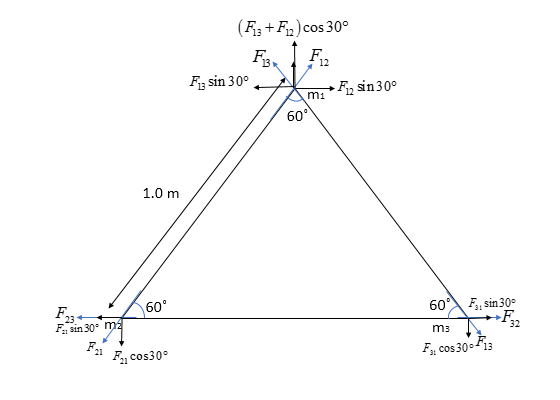
Concept explainers
To Find: The resultant gravitational force on each particle.
Explanation of Solution
Given:
Mass of each particle,
Distance between particles,
Formula used:
The gravitational force between two bodies having mass m and M , d distance away is:
G is the gravitational constant.
Calculation:
Free body diagram:

Gravitational force on
The gravitational force on
Gravitational force on
Conclusion:
Thus, resultant gravitational force on
Want to see more full solutions like this?
Chapter 6 Solutions
EBK PHYSICS FUNDAMENTALS
- Let gM represent the difference in the gravitational fields produced by the Moon at the points on the Earths surface nearest to and farthest from the Moon. Find the fraction gM/g, where g is the Earths gravitational field. (This difference is responsible for the occurrence of the lunar tides on the Earth.)arrow_forwardCalculate the effective gravitational field vector g at Earths surface at the poles and the equator. Take account of the difference in the equatorial (6378 km) and polar (6357 km) radius as well as the centrifugal force. How well does the result agree with the difference calculated with the result g = 9.780356[1 + 0.0052885 sin 2 0.0000059 sin2(2)]m/s2 where is the latitude?arrow_forwardSuppose the gravitational acceleration at the surface of a certain moon A of Jupiter is 2 m/s2. Moon B has twice the mass and twice the radius of moon A. What is the gravitational acceleration at its surface? Neglect the gravitational acceleration due to Jupiter, (a) 8 m/s2 (b) 4 m/s2 (c) 2 m/s2 (d) 1 m/s2 (e) 0.5 m/s2arrow_forward
- The Sun has a mass of approximately 1.99 1030 kg. a. Given that the Earth is on average about 1.50 1011 m from the Sun, what is the magnitude of the Suns gravitational field at this distance? b. Sketch the magnitude of the gravitational field due to the Sun as a function of distance from the Sun. Indicate the Earths position on your graph. Assume the radius of the Sun is 7.00 108 m and begin the graph there. c. Given that the mass of the Earth is 5.97 1024 kg, what is the magnitude of the gravitational force on the Earth due to the Sun?arrow_forwardThe gravitational force exerted on an astronaut on the Earths surface is 650 N directed downward. When she is in the space station in orbit around the Earth, is the gravitational force on her (a) larger, (b) exactly the same, (c) smaller, (d) nearly but not exactly zero, or (e) exactly zero?arrow_forwardA point mass m is located a distance D from the nearest end of a thin rod of mass M and length L along the axis of the rod. Find the gravitational force exerted on the point mass by the rod.arrow_forward
- Estimate the gravitational force between two sumo wrestlers, with masses 220 kg and 240 kg, when they are embraced and their centers are 1.2 m apart.arrow_forwardHow far from the center of the Sun would the net gravitational force of Earth and the Sun on a spaceship be zero?arrow_forward(a) Find the magnitude of the gravitational force between a planet with mass 7.50 1024 kg and its moon, with mass 2.70 1022 kg, if the average distance between their centers is 2.80 108 m. (b) What is the acceleration of the moon towards the planet? (c) What is the acceleration of the planet towards the moon?arrow_forward
- Three objects of equal mass m1 = m2 = m3 = 1.15 kg are located on the vertices of an equilateral triangle of length d = 3.40 m. A fourth mass m4 = 15.5 kg is at the center of the triangle. What is the net gravitational force on the mass m1 that is at the origin? Express your answer in vector form. Fnet?arrow_forwardThree point masses are arranged in a triangular pattern, as shown below. The massvalues are m1 = 125 kg, m2 = 155 kg and m3 = 265 kg. Find the magnitude anddirection of the total gravitational force on mass #1 due to the other two masses.arrow_forwardThe masses and coordinates of three spheres are as follows: 20 kg, x = 0.50 m, y = 1.0 m; 40 kg, x=-1.0 m, y=-1.0 m; 60 kg, x = 0 m, y=-0.50 m.What is the magnitude of the gravitational force on a 20 kg sphere located at the origin due to these three spheres?arrow_forward
 Principles of Physics: A Calculus-Based TextPhysicsISBN:9781133104261Author:Raymond A. Serway, John W. JewettPublisher:Cengage Learning
Principles of Physics: A Calculus-Based TextPhysicsISBN:9781133104261Author:Raymond A. Serway, John W. JewettPublisher:Cengage Learning Physics for Scientists and Engineers: Foundations...PhysicsISBN:9781133939146Author:Katz, Debora M.Publisher:Cengage Learning
Physics for Scientists and Engineers: Foundations...PhysicsISBN:9781133939146Author:Katz, Debora M.Publisher:Cengage Learning College PhysicsPhysicsISBN:9781305952300Author:Raymond A. Serway, Chris VuillePublisher:Cengage Learning
College PhysicsPhysicsISBN:9781305952300Author:Raymond A. Serway, Chris VuillePublisher:Cengage Learning Classical Dynamics of Particles and SystemsPhysicsISBN:9780534408961Author:Stephen T. Thornton, Jerry B. MarionPublisher:Cengage Learning
Classical Dynamics of Particles and SystemsPhysicsISBN:9780534408961Author:Stephen T. Thornton, Jerry B. MarionPublisher:Cengage Learning University Physics Volume 1PhysicsISBN:9781938168277Author:William Moebs, Samuel J. Ling, Jeff SannyPublisher:OpenStax - Rice University
University Physics Volume 1PhysicsISBN:9781938168277Author:William Moebs, Samuel J. Ling, Jeff SannyPublisher:OpenStax - Rice University




